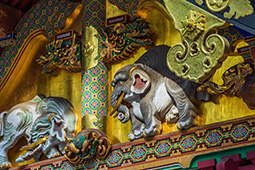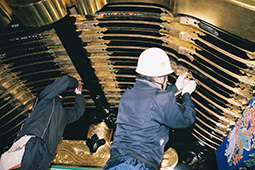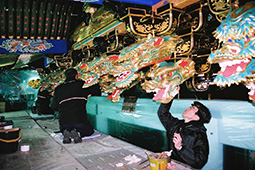October 2022
- English
- 日本語
The Glittering Beauty of the Yomeimon Gate at the Nikko Toshogu Shrine

The Yomeimon Gate at the Nikko Toshogu Shrine 
The Sima Guang carving on the Yomeimon Gate

Some of the hundreds of carvings on the Yomeimon Gate 
Decorative metal fittings (top right) on the Yomeimon Gate 
Craftsmen attach repaired metal fittings to the Yomeimon Gate 
Craftsmen renovate colorful carvings on the Yomeimon Gate

The Yomeimon Gate at the Nikko Toshogu Shrine is a glittering structure decorated with more than 240,000 pieces of gold leaf.

Nikko City in Tochigi Prefecture is about two hours from Tokyo by the fastest train route. The city is famous for its shrines and temples, specifically a group of 103 shrines and temples of great artistic and historical value which, together with their natural surroundings, in 1999 were registered as a UNESCO World Cultural Heritage Site.
Particularly well-known among the components of the site is the Nikko Toshogu Shrine complex, which was built in 1617 and reconstructed by Tokugawa Iemitsu in 1636, the third shogun, to worship Tokugawa Ieyasu (1543–1616), the first shogun of the Edo shogunate.* Many of the structures in the complex are decorated with gold leaf. Particularly eye-catching is the Yomeimon Gate, a National Treasure which is covered with about 240,000 sheets of gold leaf. The gate is about 7 meters wide between the pillars, 4 meters deep, and 11 meters high, and is decorated with 508 elaborate carvings of dragons, phoenixes, and other imaginary animals as well as events and sages including those from ancient China. It is known as “the most beautiful gate in Japan” and is also called “the all-day gate” because it’s impossible to get tired of looking at it.
Since their construction, the shrines at the Nikko Toshogu Shrine complex, including the Yomeimon Gate, have undergone 21 major and minor repairs, thus maintaining their beauty.
Yamasaku Yoshiyuki of the Nikko Toshogu General Affairs Office explains, “In 2017, after completing a four-year period of repairs using traditional techniques, the Yomeimon Gate was once again restored to its former beauty. For example, the gilding on the decorative metal fittings attached to various parts (see photo) faithfully reproduced the appearance of the original building using the traditional technique of applying mercury to copper plates, applying gold leaf to that, then firing them to vaporize the mercury and fix the gold, a different technique from modern electroplating.”

About 240,000 pieces of 10.9 cm square gold leaf are used in total for the gilding of the metal fittings and lacquered wooden parts of the Yomeimon Gate. Each leaf is extremely thin, at just 1/10,000th of a millimeter, and the leaves are carefully and uniformly attached one by one using lacquer and glue as an adhesive and making sure they are completely flat. Kanazawa gold leaf (see here) processed in Kanazawa City, Ishikawa Prefecture was used for all the repairs that were completed in 2017. It is said that the same amount of gold leaf was used at the time of construction. In this repair, the damaged coating was scraped off, new lacquer was applied, and the gold leaves were reapplied.


Moreover, a technique in which color is added by applying iwaenogu, a traditional Japanese paint made from natural minerals, on top of the gold leaf is used in selected spots to make the carvings of animals, plants and patterns appear more vivid. Even if the iwaenogu on the surface peels off due to exposure to wind and rain, the gold leaf will appear from below, thus revealing a different kind of beauty.
The enormous carvings on the Yomeimon Gate are not just designs; they also contain ideas and messages. Yamasaku says he attaches special importance to the sculpture on the second-level railing, “Sima Guang Breaks the Vat.”

“It depicts a scene where Sima Guang (1019–1086), a scholar of the Northern Song Dynasty (960–1127) in China, as a child wanted to help a friend who had fallen into a precious water vat, so he breaks it with a rock. The story teaches us that there is nothing more precious than human life. I think it is a symbolic sculpture that captures the heart to realize a peaceful world that Lord Ieyasu aimed for.”
The Yomeimon Gate has many other carvings with interesting ideas and messages. These stories add yet more depth to the glittering golden glow of the abundant gold leaf.
* It continued for 15 generations over 260 years from 1603 when Tokugawa Ieyasu became shogun.

